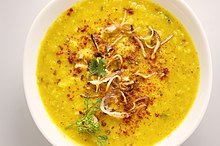Dal
In Indian cuisine, dal (also spelled daal or dhal [1] pronunciation: [d̪aːl]), parippu, pappu, or paruppu are dried, split pulses (e.g., lentils, peas, and beans) that do not require soaking before cooking.
[6][7][8] Lentils are among the most ancient cultivated foods; they have been found in human settlements dating back to the Bronze Age.
[10] Dal as a staple food has been mentioned in many ancient religious texts, including the Yajurveda, the Mahayana Buddhist Laṅkāvatāra Sūtra, and the Bible: May for me strength, righteousness, milk, sap, ghee, honey, eating and drinking in company, ploughing, rain, conquest, victory, wealth, riches, prosperity, prospering, plenteousness, lordship, much, more, fun, fuller, imperishableness, bad crops, food, freedom from hunger, rice, barley, beans, sesame, kidney beans, vetches, wheat, lentils, millet, Panicum miliaceum, Panicum frumentaceum, and wild rice (prosper through the sacrifice).Now, Mahāmati, the food I have permitted [my disciples to take] is gratifying to all wise people but is avoided by the unwise; it is productive of many merits, it keeps away many evils; and it has been prescribed by the ancient Rishis.
It also affects the nutrition provided by the dish, significantly increasing protein and reducing dietary fibre content.
The standard preparation begins with boiling a variety of dal (or a mix) in water with some turmeric, salt to taste, and then adding a fried garnish at the end of the cooking process.
[18] In some recipes, tomatoes, kokum, unripe mango, jaggery, or other ingredients are added while cooking the dal, often to impart a sweet-sour flavour.
After the onion turns golden brown, ground spices (turmeric, coriander, red chili powder, garam masala, etc.)


